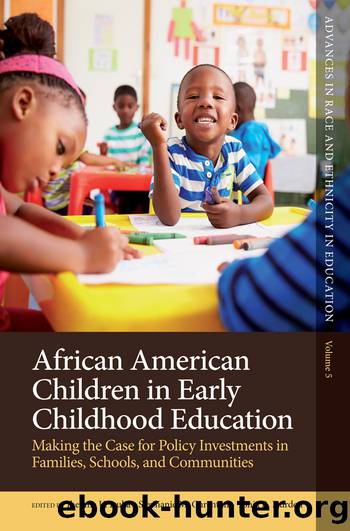African American Children in Early Childhood Education by Iruka Iheoma U.;Curenton Stephanie M.;Durden Tonia R.;Durden Tonia R.;Iruka Iheoma U.;

Author:Iruka, Iheoma U.;Curenton, Stephanie M.;Durden, Tonia R.;Durden, Tonia R.;Iruka, Iheoma U.;
Language: eng
Format: epub
Publisher: Emerald Publishing Limited
Published: 2017-05-19T00:00:00+00:00
EPIDEMIOLOGY
Consistent with Shonkoffâs conceptualization, a preponderance of research underscores the vulnerability of African American children. First, the negative impact of poverty and its concomitants on childrenâs developmental outcomes has been extensively documented (Aber, Brown, Hoglund, & Jones, 2010; Duncan et al., 2010). Children have higher rates of poverty than any other demographic group, particularly young children under six years of age. In fact, 47% of young children live in low-income households (i.e., less than 200% of poverty threshold) and 24% live in poor households (i.e., below the poverty line). Further, the rates of young children in deep poverty (i.e., 50% or less of the federal poverty line) have increased (Ekono, Yang, & Smith, 2016; Jiang, Ekono, & Skinner, 2016).
African American children are disproportionately reared in impoverished environments (Jiang et al., 2016). According to the Pew Research Centerâs recent analysis of the 2010â2013 U.S. Census Data, African American childrenâs rate of poverty has stabilized, whereas there has been a decline in the poverty rates of their White and Hispanic counterparts (Patten et al., 2014). Further, the most recent census data indicate that despite a decrease in poverty rates overall, almost one-third of African American children live in poverty (Proctor, Semega, & Kollar, 2016). Particularly relevant for this chapter, African American children under six years of age are more likely to be poor (i.e., 69%) than any of their counterparts in other racial/ethnic groups (Jiang et al., 2016).
Many early childhood adversities are associated with children being reared in impoverished environments. For example, the ACE study found that poor/near-poor children are twice as likely to have had three or more adverse experiences compared to their well-off peers (Felitti et al., 1998). In an analysis by Ekono et al. (2016), children living in poverty were more likely to live with mothers who had compromised physical and mental health as well as increased parenting stress. Poverty is a major risk factor for depression, the most common mental health disorder, with maternal depression rates as high as 52% reported in studies of low-income samples (U.S. Department of Health and Human Services Administration for Children and Families, 2006; Zayas et al., 2002).
African American children may be a particularly vulnerable group in this regard, as their mothers may have higher rates of mental health challenges (Dailey & Humphreys, 2011). Ethnic minority women are disproportionately poor, single, and exposed to a range of chronic stressors associated with living in impoverished communities (Kramer, Séguin, Lydon, & Goulet, 2000; Williams & Jackson, 2005). For example, although the literature is ambiguous, there is some evidence that the prevalence of maternal depression in the United States is higher among African American and Hispanic women compared to European American women (Gavin et al. 2011; Melville, Gavin, Guo, Fan, & Katon, 2010; Rich-Edwards, 2006; Segre, OâHara, Arndt, & Stuart, 2007). Other research suggests that in the United States, poverty is a more powerful predictor than race, and that for poor women, rates of depression are high regardless of ethnicity (Yonkers et al., 2001).
Young children who
Download
This site does not store any files on its server. We only index and link to content provided by other sites. Please contact the content providers to delete copyright contents if any and email us, we'll remove relevant links or contents immediately.
Chicken Soup for the Soul Presents Teens Talkin' Faith by Jack Canfield(649)
Understanding PDA Autism in Kids: A Guide for Parents and Teachers to Support Neurodiverse Learners by Jehu Len(555)
The Victorian Era: A Captivating Guide to the Life of Queen Victoria and an Era in the History of the United Kingdom Known for Its Hierarchy-Based Social Order by Captivating History(424)
Brain Teasers to Build Critical Thinking Skills by Safarova Kris(411)
Brain Teasers to Build Critical Thinking Skills: Brain Exercises for Tech, Banking, Case Interview Prep, and to Keep Your Mind Sharp by Kris Safarova(411)
100 Ideas for Secondary Teachers: Engaging Parents by Janet Goodall & Kathryn Weston(388)
Python 101 - Fundamentals by Sam(373)
Critical Curriculum Leadership : A Framework for Progressive Education by Rose M. Ylimaki(363)
Writing Solid Code: Development Philosophies for Writing Bug-Free Programs by Steve Maguire(357)
The Art of Emotional Validation: Improve Your Communication Skills and Transform Your Relationships by Validating Emotions and Feelings by Emily Wright(339)
Intersectionality in Educational Research by Dannielle Joy Davis; James L. Olive; Rachelle J. Brunn-Bevel; Susan R. Jones(331)
The Knights Templar: An Enthralling History of the Rise and Fall of the Most Influential Catholic Military Order by Wellman Billy(330)
A Beginner's Guide to SSD Firmware by Unknown(327)
The Future Knowledge Compendium by Ellyard Peter;(319)
How to be assertive in any situation by Hadfield Sue & Hasson Gill(310)
Making Connections in and Through Arts-Based Educational Research by Hala Mreiwed Mindy R. Carter Sara Hashem Candace H. Blake-Amarante(306)
Foundations of Educational Research by Victoria Elliott(305)
What Every Teacher Should Know about Learning, Memory, and the Brain by Tileston Donna E. Walker;(305)
Message from the Pleiades; The Contact Notes of Eduard Billy Meier v1 only by unknow(301)
